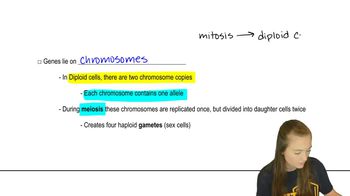Here are the essential concepts you must grasp in order to answer the question correctly.
DNA Structure and Function
DNA, or deoxyribonucleic acid, is the hereditary material in humans and almost all other organisms. It consists of two strands forming a double helix, with each strand made up of nucleotides containing a sugar, phosphate group, and a nitrogenous base. The sequence of these bases encodes genetic information, which is crucial for understanding how traits are inherited and how paternity can be established through genetic testing.
Recommended video:
Genetic Inheritance
Genetic inheritance refers to the process by which genetic information is passed from parents to offspring. In humans, each child inherits half of their DNA from their mother and half from their father. This concept is essential for paternity testing, as the child's DNA profile should show a combination of alleles from both parents, allowing for the identification of biological relationships.
Recommended video:
DNA Profiling
DNA profiling, also known as DNA fingerprinting, is a technique used to identify individuals based on their unique DNA characteristics. In paternity cases, specific regions of DNA are analyzed to compare the genetic markers of the child with those of the potential fathers. The presence of matching bands in the DNA test results indicates a biological relationship, while discrepancies can help exclude non-biological fathers.
Recommended video:






